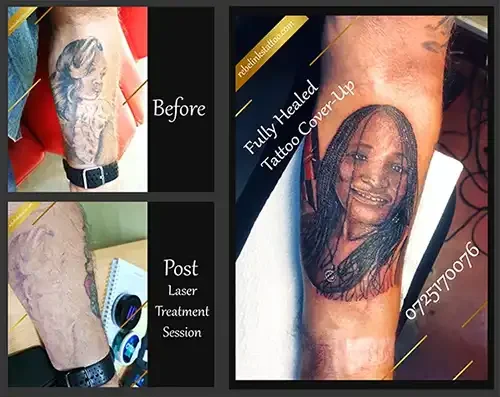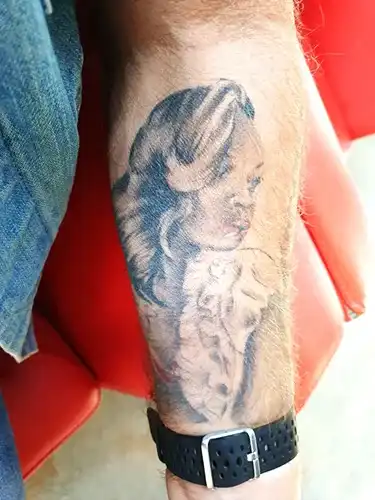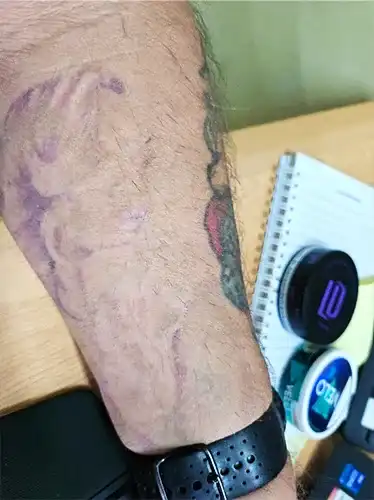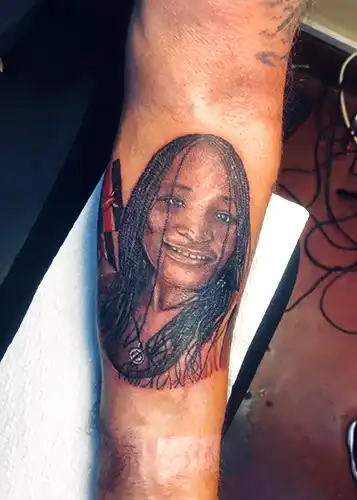Picosecond Laser Tattoo Removal in Nairobi, Kenya
Picosecond lasers are a type of laser technology that produces extremely short pulses of light, measured in picoseconds (trillionths of a second). These lasers have gained popularity in various medical and cosmetic applications, including tattoo removal. The principle behind picosecond lasers is that the ultra-short pulses of light can more effectively break down tattoo pigments into smaller particles compared to traditional nanosecond lasers.

Picosecond Lasers
Picosecond Laser Tattoo Removal Process
The picosecond laser tattoo removal process is similar to traditional laser tattoo removal, but it utilizes a laser with ultra-short pulses measured in picoseconds. Here is an overview of the typical steps involved in picosecond laser tattoo removal:
- Consultation: The process begins with a consultation with a qualified practitioner. During this consultation, at Rebel Inks Tatt00s, Tattoo Removal, and Body Piercings, our practitioner assesses the tattoo, discusses your medical history, skin type, and expectations, and determines if picosecond laser technology is suitable for the specific tattoo.
- Preparation: Before the actual treatment, the practitioner may apply a topical anesthetic to minimize discomfort during the procedure. Protective eyewear is also typically provided to shield the eyes from the laser light.
- Skin Testing: In some cases, a small area of the tattoo or a test spot on the skin may be treated with the picosecond laser to observe how the skin reacts and to determine the appropriate laser settings for the individual.
- Laser Treatment: The picosecond laser emits ultra-short pulses of high-energy light. This light is directed onto the tattooed area, targeting the ink particles within the skin.
- Photoacoustic Effect: The ultra-short pulses create a photoacoustic effect, generating pressure waves that break down the tattoo pigments into smaller particles. These smaller particles are more easily absorbed and eliminated by the body’s natural processes.
- Cooling: Some picosecond laser systems include built-in cooling mechanisms or may be used in conjunction with external cooling devices to minimize heat and discomfort during the procedure.
- Post-Treatment Care: After the treatment, the treated area may appear red, swollen, or have a mild burning sensation. The practitioner will provide specific post-treatment care instructions, which may include applying ice packs, using prescribed ointments, and avoiding sun exposure.
- Recovery and Follow-Up: The recovery time varies depending on the individual’s skin response and the size and location of the treated tattoo. Multiple sessions are typically required for complete tattoo removal, and follow-up appointments are scheduled to assess progress and determine the need for additional treatments.
- Possible Side Effects: While picosecond lasers are designed to minimize side effects, some temporary effects may occur, such as redness, swelling, blistering, and mild discomfort. Serious side effects are rare when the procedure is performed by a qualified and experienced practitioner.
- Subsequent Sessions: Additional laser sessions are scheduled based on the rate of tattoo clearance and the individual’s response to the treatment. The intervals between sessions allow the skin to heal and the body to eliminate the broken-down ink particles.
It’s important to note that the effectiveness of picosecond laser tattoo removal can vary depending on factors such as tattoo characteristics, ink colors, and individual skin response. Consulting with a skilled and experienced practitioner is essential to determine the most appropriate treatment plan for achieving the desired results.
Picosecond Laser Tattoo Removal Mechanism
The picosecond laser tattoo removal mechanism involves the use of a laser that emits ultra-short pulses of light, typically in the picosecond range (trillionths of a second). This technology is designed to enhance the breakdown of tattoo pigments more efficiently compared to traditional lasers with longer pulse durations. The key mechanism of picosecond laser tattoo removal is known as the “photoacoustic” effect, and the process can be broken down into several steps:
- Ultra-Short Pulses: The picosecond laser produces pulses of light that are extremely short in duration, typically around one picosecond or a few hundred picoseconds. These ultra-short pulses are shorter than the pulses produced by traditional Q-switched lasers, which operate in the nanosecond range.
- Absorption by Tattoo Pigments: When the ultra-short pulses of light are directed onto the tattooed skin, they are preferentially absorbed by the tattoo pigments. Different wavelengths are used to target specific colors of ink within the tattoo.
- Photoacoustic Effect: The ultra-short pulses create a photoacoustic effect within the skin. This effect involves the rapid heating of the tattoo pigments in a localized area. The intense and rapid heating generates a pressure wave or acoustic shockwave.
- Ink Fragmentation: The pressure wave generated by the photoacoustic effect is strong enough to cause mechanical disruption of the tattoo pigments. The ink particles are broken down into smaller, more manageable fragments.
- Increased Particle Clearance: The smaller ink fragments resulting from the photoacoustic effect are easier for the body’s immune system to recognize and eliminate. The enhanced fragmentation is believed to facilitate a more efficient clearance of tattoo pigments from the skin.
- Minimized Thermal Damage: The ultra-short pulses of picosecond lasers help to minimize the amount of heat generated in the surrounding tissues. This is in contrast to longer-pulse lasers, where more heat may be produced, potentially leading to unwanted side effects such as scarring or changes in pigmentation.
- Precision and Selectivity: The precision of picosecond lasers allows for targeted and selective treatment of tattoo pigments without causing extensive damage to surrounding skin structures. This characteristic is particularly advantageous for minimizing side effects and promoting faster healing.
- Color Versatility: Picosecond lasers are effective across a broad spectrum of colors, making them suitable for removing tattoos with different pigments, including dark and stubborn colors like green and blue.
The picosecond laser tattoo removal mechanism capitalizes on the ultra-short pulses to induce a rapid and precise breakdown of tattoo pigments, facilitating improved clearance of tattoos with potentially fewer side effects. The technology is continually evolving, and advancements aim to enhance the efficacy and safety of tattoo removal procedures.

Before

Post Laser Tattoo Removal



Healed Tattoo Cover Up Post Laser Tattoo Removal
Picosecond Laser Tattoo Removal Aftercare
After undergoing picosecond laser tattoo removal, proper aftercare is crucial to promote healing, minimize potential side effects, and optimize the results of the treatment. While specific recommendations may vary among practitioners, here are general guidelines for picosecond laser tattoo removal aftercare:
- Immediate Post-Treatment Care: The treated area may be sensitive immediately after the procedure. The practitioner may apply a soothing gel or ointment to the area to minimize discomfort and promote healing.
- Cooling and Soothing Measures: Apply ice packs wrapped in a thin cloth to the treated area intermittently during the first few hours after the procedure. This can help reduce swelling and soothe the skin.
- Avoid Sun Exposure: Protect the treated area from direct sunlight and UV radiation. Use a broad-spectrum sunscreen with a high SPF if the treated area is exposed to sunlight. It’s advisable to wear protective clothing or avoid sun exposure during the healing period.
- Avoid Hot Baths and Saunas: Refrain from hot baths, saunas, and hot tubs for a few days after the treatment to prevent unnecessary irritation to the treated skin.
- Gentle Cleansing: Clean the treated area gently with mild soap and water. Avoid abrasive cleansers, and pat the area dry instead of rubbing.
- Moisturize: Apply a fragrance-free, hypoallergenic moisturizer to the treated area to keep the skin hydrated and alleviate dryness. This can also help prevent excessive peeling.
- Avoid Scratching: Refrain from scratching or picking at the treated area, as this can disrupt the healing process and increase the risk of infection.
- Avoid Makeup and Fragrances: Avoid applying makeup or using fragranced products on the treated area until it has fully healed to prevent irritation.
- Follow Practitioner’s Recommendations: Adhere to any specific aftercare instructions provided by your practitioner. They may tailor their recommendations based on your individual response to the treatment.
- Hydrate and Maintain Overall Health: Drink plenty of water to stay hydrated, which can contribute to overall skin health. Adopt a healthy lifestyle with a balanced diet and sufficient rest to support the body’s natural healing processes.
- Follow-Up Appointments: Attend any scheduled follow-up appointments with your practitioner. They will assess the healing progress, address any concerns, and determine the need for additional treatment sessions.
- Avoid Smoking and Alcohol: If possible, avoid smoking and excessive alcohol consumption during the healing period, as these can impede the healing process.
Advantages of Picosecond Laser Tattoo Removal
Picosecond laser tattoo removal has gained popularity due to several advantages it offers over traditional Q-switched lasers. Here are some key advantages of picosecond laser tattoo removal:
- Faster Clearance: The ultra-short pulses of picosecond lasers result in a more efficient and thorough fragmentation of tattoo pigments. This can lead to faster tattoo clearance compared to traditional Q-switched lasers, potentially reducing the overall number of treatment sessions needed.
- Enhanced Ink Fragmentation: The picosecond pulse duration creates a photoacoustic effect that generates a shockwave within the tattoo pigments, leading to more effective and smaller ink particle fragmentation. The smaller particles are easier for the body’s immune system to clear.
- Color Versatility: Picosecond lasers are effective across a broad spectrum of colors, including challenging colors like green and blue. This color versatility makes them suitable for treating tattoos with diverse ink pigments.
- Reduced Thermal Damage: The ultra-short pulses result in minimal heat buildup, reducing the risk of thermal damage to surrounding tissues. This helps preserve the integrity of the skin and decreases the likelihood of side effects such as scarring or changes in pigmentation.
- Versatility in Applications: In addition to tattoo removal, picosecond lasers are used for various dermatological and cosmetic applications. They can target pigmented lesions, improve skin texture, and address concerns such as acne scars and fine lines.
- Minimized Discomfort: The shorter duration of the laser pulses may lead to reduced discomfort during the procedure. Additionally, some picosecond laser systems incorporate cooling mechanisms to further enhance patient comfort.
- Reduced Risk of Hypopigmentation: Hypopigmentation (lightening of the skin) is a potential side effect of laser tattoo removal. Picosecond lasers are designed to minimize this risk by reducing the amount of heat generated and the impact on surrounding pigmentation.
- Suitability for Stubborn Colors: Picosecond lasers are particularly effective for treating tattoos with stubborn colors such as green and blue. These colors can be more challenging to remove with traditional lasers.
- Precision and Selectivity: The ultra-short pulses allow for precise targeting of tattoo pigments without causing extensive damage to surrounding tissues. This precision contributes to better outcomes and faster healing.
- Combination with Fractional Technology: Some picosecond lasers incorporate fractional technology, enabling both targeted treatment of specific areas and overall skin improvement. This combination is known as PicoFractional technology.
It’s important to note that while picosecond laser tattoo removal has many advantages, individual responses can vary, and complete tattoo removal may not always be achievable. Consulting with a qualified and experienced practitioner is essential to assess the specific characteristics of the tattoo and determine the most suitable treatment plan for optimal results.
Get In Touch
For more information on the list above and any other special services,please call or come in for free consultation
Testimonials
After he pierced my industrial piercing and seeing his amazing work, I feel even more excited about getting my tattoo with him in January. I’m really looking forward to it!
I am extremely happy with my new 'Safari' tattoo from Eric at Rebel Inks! The quality of the artwork is fantastic. Eric is a true professional and an amazing artist.
The preparation and design process was thorough and collaborative. He was very patient with my specific requests, including making sure all the elements, which hold personal meaning, were perfect.
The service was friendly and highly professional from start to finish. Despite the 8-hour session, Eric was a pleasant person to spend the time with.
The aftercare guidance and follow-up have been excellent and careful, which has made the healing process easy and better than expected.
I highly recommend Eric for anyone looking for a thoughtful, talented, and caring tattoo artist.
I recommend them 💯
I would definitely recommend if you’re thinking of getting a piercing!
The staff were super friendly, explained everything clearly, and made me feel so at ease. They answered all my nervous questions (and I had many questions),
They walked me through the whole process, gave detailed aftercare instructions, and even followed up afterward to check how I was healing 🫶
Clean, professional, and full of good vibes.
Would 100% recommend . Definitely making a second trip here.
This was the second tattoo I got and I wish I could have come to Eric for my first one! He gave me really great after-care directions for the tattoo as well as a little jar of his own Vaseline-type stuff to put over my tattoo while it was healing! He even put second skin over my tattoo so that I didn’t have to worry about it for the first few days. Now THAT’S good service. My first tattoo artist didn’t do none of that lol.
After the session Eric didn’t rush me and my friend out, he chatted with us and even when he found out I was an artist too— really encouraged me to keep creating and to find a community of artists to support me. I almost cried because I’ve had such a hard time with my own art the past couple of years, it meant so much to me to have a fellow very talented artist say that to me. 🤍🤍🤍
Eric you’re amazing, don’t ever stop creating and just know you’ve impacted lives all over the world!🫶🏻 thanks so much for everything!!
From the moment I walked in, Eric was professional, welcoming, and attentive. He made sure I was comfortable throughout, provided everything I needed, and explained every step of the process. The tattooing itself was unbelievably smooth - I genuinely felt no pain compared to my previous tattoos over the last 22 years.
Eric also gave me excellent aftercare guidance and products, and thanks to that, my tattoo healed beautifully. The attention to detail, precision, and shading are absolutely stunning. This is hands-down the best tattoo I've ever had, and I will be flying back to Nairobi for any future ink.
If you want incredible art, a professional experience, and a talented artist who truly cares about his clients, Rebel Ink is the place to go!
From start to finish, the service was exceptional. The piercer was professional, knowledgeable, and made me feel completely comfortable. The cleanliness of the place was above and beyond — everything was spotless and hygienic, which really put me at ease. Highly recommend for anyone considering a piercing!
Shout out to Eric😘
We ended up changing the jewelry three times to ensure I had the best fit and avoided any signs of rejection, and he always listened to my suggestions as a client, which I really appreciated. Now, three months in, my piercing is healing beautifully, with no sign of rejection. Highly recommend for anyone who values a piercer who cares about your comfort and healing journey!
What stood out the most was the aftercare Eric checked in with me even three weeks later to see how the tattoo was healing. That kind of follow-up shows how much he truly cares about his work and his clients.
I’m very satisfied and will definitely be coming back for my next piece. Highly recommend!
The piercing wasn't as painful as I had thought and the process was quick and satisfactory. I love it!!!
The piercing is healing well thanks to the aftercare instructions and follow-up. I would highly recommend Rebel Inks
Eric also did a belly button piercing for a friend, guiding her through the process, doing the piercing and then explaining the after care to her.
The shop is on the 3rd floor, with the entrance to the stairs near an alleyway on the left. The shop is perfect size, clean, and attractive looking. The mural is pretty dope.
Thank you for the amazing service! 🔥👅✨
I got piercibgs there and the process was really good. My biggest concern was hygiene but that wasn't an issue at all, they use new needles and they sanitize them.
The service itself was also welcoming.
I was informes of everything i needed to know beforehand.
10/10 would recommend!
Eric was so calm and patient with my almost 2 year old lady. It was such a clean and hygienic process. We will definitely be back for our second rounds of piercings and maybe even another tattoo!
They assess the area before any art and advise one accordingly. They also give one post clean up process and also do a check up after the body art projects. Overall, I loved my experience and I’m hooked. 👍
Will definitely come back next time I’m in town 🙂
He listened to what I actually wanted and made sure he could fit in the time before I flew back home.
The shop is clean & private and is easy enough to find.
Eric has even checked in a couple of times since to make sure all is good.
I would totally recommend Eric! I absolutely love my Elephants!
I had a very easy healing period and always follow up from Eric to check on my progress...I would highly recommend if you are a first timer because from my experience all went very well and attention to detail
Thank you for a good job and looking forward to send all my friends your way
And all the best with the new year 2025!
From the moment I walked in, the staff was super friendly and made me feel at ease. The studio had a clean, professional atmosphere, which immediately put me at ease. My piercer was incredibly skilled and explained every step of the process, ensuring I was comfortable the entire time. The piercing was quick and practically painless, and the aftercare instructions were clear and easy to follow. I can tell they really care about the health and safety of their clients.
Overall, a fantastic experience—I highly recommend Rebel Inks and Tattoos for anyone looking to get pierced or tattooed!
They do follow up after their services
Eric's Studio isn’t just a place to get a tattoo—it’s an experience. The combination of professionalism, artistic talent, and a welcoming environment makes it a standout destination for anyone considering a tattoo.
I highly recommend Eric’s Studio to both first-timers and seasoned tattoo enthusiasts. If you’re looking for a high-quality tattoo and an enjoyable experience, this is the place to go.
I would definitely recommend their services again and again
Thank you Rebel Ink
My piercings are healing ❤️🩹 well
I would 💯 recommend
I will definitely come back for more .
Two, all the equipments he used for the piercings were new and/or sterilised.
Three, the parlour itself was very clean and was up to par with the hygiene standards.
Four, Eric provided effective aftercare instructions, making sure I knew exactly how to take care of my new piercings and he kept in touch and continues to do so, to check on the healing progress.
I highly highly highly recommend this place!!!
Would definitely recommend them to friends and go back for other piercings
Not only was the piercing process smooth, but he also provided thorough aftercare instructions, making sure I knew exactly how to take care of my new piercings. What really impressed me was that he keeps in touch to check on how the healing is progressing – a sign of true care for his clients.
The shop maintains a high standard of hygiene, and the atmosphere is welcoming and comfortable, which really added to the positive experience. I highly recommend this place to anyone looking for a professional and caring experience. I’ll definitely be coming back for any future piercings!
My appreciation for the excellent customer service I received. The follow-ups were prompt, and I truly appreciated the gentleness and professionalism throughout. Thank you!"
"Looking for professional eyebrow microshading removal? Look no further!"
The customer care is top tier 👌🏾👌🏾.
Wonderful place to get tattoos and piercings. 💯💯
Eric goes ahead to follow up on his clients progress and gives good advice each time I reach out to him.
I would recommend Reble tattoos anytime.
Good job bro we really appreciate.
Ohh and the price is very fair.
The environment was clean , procedure was sterile and the jewelry used are of the best quality.
He followed up with me during the healing process, he educated me on what I needed to do for my aftercare.
Eric is confident, skilled , experienced and the best piercer. Highly recommend Rebel inks.✨
Definitely recommend!
Great experience.
Eric definitely know what he is doing .
I got exactly what I wanted 2 tiny tats on the same finger .
He was kind and patient throughout the session.
Healing process has been good .
Aftercare services were given and regular checkups on the healing process were done.
I would 💯recommend.
Eric gave me the best reception as it was my first time there,and made me trust him all the way. I appreciate good services.
There services are also affordable not to forget 😊.
He was also invested in the aftercare and would ensure I follow the do's and don'ts in taking care of the tattoo and ensuring proper healing and maximum ink retention.
Would highly recommend Rebel Inks Tattoos.
Rebel Inks Tattoo offer the best,affordable and quality tattoo removal services.If you have unwanted ink,choose Rebel Inks Tattoo,they're the best of the best and the professionalism is a top notch.They ensure you're free from unwanted ink with their Laser Tattoo Removal Technology...
I did a Laser Tattoo Removal with them and i can attest they're the best....
Kudos Eric...
I highly recommend.
It was a generally good experience with good hygiene during the piercing process and has been a smooth healing process.... 10/10
tips. Highly recommend 👍🏽
100% recommendable.
I was particularly impressed with Eric's attention to hygiene. He thoroughly cleaned the room before I entered, sanitized all of the equipment he would be using, and changed gloves between each ear. This level of cleanliness gave me great confidence in his professionalism.
Eric's commitment to customer service did not end on the day of the piercing. He followed up with me regularly throughout the healing process to ensure that I was following the aftercare instructions and that my earlobes were healing properly.
I highly recommend Rebel Inks to anyone in Nairobi who is considering getting a piercing. Eric is a highly skilled and experienced piercer who takes great pride in his work.
So I Check all the boxes below and more:
Customer Care: ✔️
Professionalism : ✔️
Cleanliness ✔️
Price: ✔️
After care service ✔️
Thanks and good job, Eric
The place is neat and clean and the equipments he used were also fine standards. Really appreciate his following up with me on the healing 🤗
I WOULD HIGHLY RECOMMEND THEIR SERVICES to everyone. Actually what you see on their website is EXACTLY what you will get. Keep up the good work Rebel inks Tattoos.
The infection is now gone. I would definitely recommend!
Can recommend this place totally and would go back there anytime!
Thanks!
OUR LOCATION
Areas We Serve
NAIROBI
KIAMBU
KAJIADO
MACHAKOS

















































































































































































































